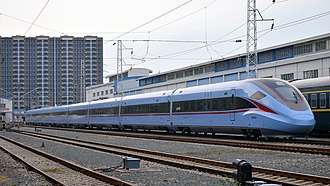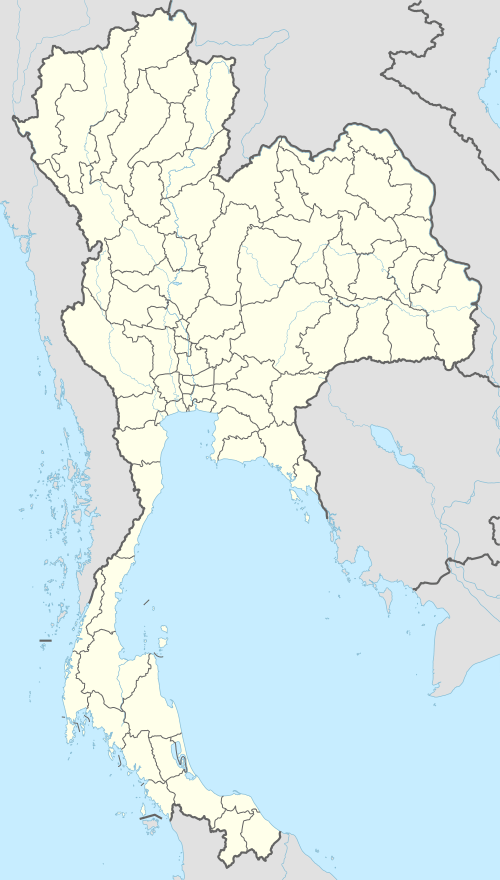Bangkok–Nong Khai high-speed railway
The Bangkok–Nong Khai high-speed railway or Northeastern high-speed rail line is a high-speed railway under construction in Thailand. It is the first high-speed line in Thailand and constituent part of the Kunming–Singapore railway Central section. Its first phase, between Bangkok and Nakhon Ratchasima, is due to open in 2023.[1]
| Bangkok–Nong Khai high-speed rail line | |
|---|---|
 CRRC Fuxing Series EMU proposed for Northeastern high-speed rail line passenger services | |
| Overview | |
| Type | High-speed rail |
| Status | Under construction |
| Locale | Thailand |
| Termini | Bangkok Nong Khai |
| Operation | |
| Opened | 2023[1] |
| Operator(s) | State Railway of Thailand |
| Technical | |
| Line length | 252 km (157 mi) |
| Track gauge | 1,435 mm (4 ft 8 1⁄2 in) |
| Operating speed | 250 km/h |
Official name
The official name of the line is the Cooperation between the Government of the Kingdom of Thailand and the Government of the People's Republic of China on Bangkok - Nong Khai HSR Development for Regional Connectivity (Thai: โครงการความร่วมมือระหว่างรัฐบาลแห่งราชอาณาจักรไทย และรัฐบาลแห่งสาธารณรัฐประชาชนจีน ในการพัฒนาระบบรถไฟความเร็วสูงเพื่อเชื่อมโยงภูมิภาค ช่วงกรุงเทพมหานคร - หนองคาย).
History
High-speed rail in Thailand was first planned by the Thai parliament in 2010 with a proposal of five routes radiating from Bangkok.[2]
In March 2013, the transport minister revealed that only one company would be selected to run all high-speed train routes, scheduled to be operational between 2018 and 2019.[3] The first 86 km section from Bang Sue Grand Station to Ayutthaya was planned to be tendered in late-2013; however following the 2014 Thai coup d'état, plans were deferred.
In November 2014, Thailand and China signed a memorandum of understanding agreeing to construct the Thai portion of the transnational railway running from Kunming, China to the Gulf of Thailand. In November 2015, both parties agreed to a division of labour. Under the framework, a joint venture will be set up to run the project. China will conduct feasibility studies, design the system, construct tunnels and bridges, and lay track. Thailand will conduct social and environmental impact studies, expropriate land for construction, handle general civil engineering and power supply, and supply construction materials.
China will operate and maintain the system for the first three years of operation. Both countries will share responsibility from the third to seventh years. Afterwards, Thailand will have sole responsibility, and China will advise. China will provide training for operations and maintenance.[4]
Dual standard-gauge tracks will be laid in the project. In Thailand, two routes will diverge at a junction in Kaeng Khoi District in Saraburi Province. One will connect Bangkok to Kaeng Khoi. The other route will connect Kaeng Khoi with Map Ta Phut of Rayong Province. From Kaeng Khoi tracks will lead north to Nakhon Ratchasima and on to Nong Khai Province. The Bangkok to Nong Khai HSR line will connect to the 417 km (259 mi) Vientiane–Boten railway from Vientiane to the northern Lao border and the 520 km (320 mi) line from the Lao border to Kunming.[4]
Rolling stock
Northeastern High Speed Railway will be use Fuxing Series or Fuxing Hao CR300AF High-speed rail EMU, produced by CRRC. The CR300AF models has a maximum speed of 300 km/h (Operating speed in Thailand will be 250 km/h).[5]
Construction

Construction divided into four sections: Bangkok-Kaeng Khoi, Map Ta Phut-Kaeng Khoi, Kaeng Khoi-Nakhon Ratchasima, Nakhon Ratchasima-Nong Khai. Construction of Thailand's 873 km (542 mi) portion of the railway system started in December 2017 and is expected to take three years for phase 1 to Nakhon Ratchasima. The first contract consisted of a 3.5 km section from Klong Dan to Pang Asok with a budget of 371 million baht after a nine percent decrease from the initial budget.[6]
In February 2018, the Thai transport minister stated that the contract for the first phase, the 253 km Bangkok to Nakhon Ratchasima section, will be issued by May 2018. The second contract will cover the 11 km section from Sikhio to Kut Chik.[7] The first phase of the line to Nakhon Ratchasima has been divided into 14 contracts, with contracts 3-7 to be auctioned by June 2018, while contracts 8-14 will be auctioned before the end of 2018.[8]
Construction contracts and progress
| Contracts | Details | Type | Distance (kilometers) |
Budget (million baht) |
Contractor |
|---|---|---|---|---|---|
| 1-1 | Klang Dong to Pang Asok | ground level | 3.5 | 425 | Department of Highways |
| 2-1 | Sikhio to Kut Chik | ground level | 11 | 3,115 | Civil Engineering Co., Ltd. |
| 3-1 | Kheang Khoi to Klang Dong, and Pang Asok to Ban Dai Mah | ground level and elevated | 30.21 | 9,330 | Thai Engineering Co., Ltd. |
| 3-2 | Muaklek to Lam Ta Kong | tunnel | 12.23 | 4,729.3 | Nawarat Patanakarn PLC. |
| 3-3 | Ban Dai Mah to Lam Ta Kong, including Pak Chong station | elevated | 26.10 | 9,838 | Krungthon Engineering Co., Ltd. |
| 3-4 | Lam Ta Kong to Sikhio, and Kut Chik to Khok Kruad | ground level and elevated | 37.45 | 9,788 | BNP Co., Ltd. |
| 3-5 | Khok Kruad to Nakhon Ratchasima | ground level and elevated | 13.69 | 7,750 | Napha Construction Co., Ltd. |
| 4-1 | Bangsue Central to Don Mueang Airport | elevated | 11.83 | - | Eastern High-speed Rail Linking Three Airports Co., Ltd. (included in construction contract of 3 Airports project) |
| 4-2 | Don Mueang Airport to Navanakhon | eleveted | 21.80 | 8,626 | Sino-hydro Co., Ltd. Sahakan Wisawakorn Co., Ltd. Tipakorn Co., Ltd. |
| 4-3 | Navanakhon to Ban Pho | eleveted | 23 | 11,525 | China State Construction Engineering Corporation Co., Ltd. Nawarat Patanakarn PLC. A.S. Associate Engineering (1964) Co., Ltd. |
| 4-4 | Chiang Rak Noi depot | ground level | - | 6,093 | |
| 4-5 | Ban Pho to Phra Keaw, including Ayutthaya station | ground level and elevated | 13.30 | 9,913 | Italian-Thai Development PLC. |
| 4-6 | Phra Keaw to Saraburi | ground level and elevated | 31.6 | 9,429 | Unique Engineering and Construction PLC. |
| 4-7 | Saraburi to Kheang Khoi, including Saraburi and Kheang Khoi station | ground level and eleated | 12.99 | 8,560 | ## |
Route
Phase 1: Bangkok (Bang Sue) – Don Mueang – Ayutthaya – Saraburi – Pak Chong – Nakhon Ratchasima
Phase 2: Nakhon Ratchasima – Bua Yai – Ban Phai – Khon Kaen – Udon Thani – Nong Khai

References
- "Thailand's high-speed railway will carry first passengers in 2023". The Thaiger. 4 September 2019. Retrieved 7 September 2019.
- "Thailand to negotiate with China on high-speed proposal". International Railway Journal. 30 October 2010. Archived from the original on 1 November 2010. Retrieved 30 October 2010.
- "Transport Minister: One firm will run all high-speed train routes". Thai Financial Post. 21 March 2013. Archived from the original on 2 February 2014.
- Jikkham, Patsara (17 November 2015). "Sino-Thai railway responsibilities set". Bangkok Post. Retrieved 18 November 2015.
- "Rail progress tracks full steam ahead". Bangkok Post. 2 December 2018.
- Jotikasthira, Om (23 March 2018). "Thai Chinese rail project falls in price". Bangkok Post.
- "Pace picks up on fast train project". The Nation. 9 March 2018.
- Jotikasthira, Om; Theparat, Chatrudee (9 March 2018). "New govt 'won't halt airport fast rail plan'". Bangkok Post.
.svg.png)